

Berard AIT is research supported
Effectiveness is well-documented by many studies which have been done on a variety of populations.
(1) Ocular Movements Among Individuals with Autism Pre- and Post-Auditory Integration Training
Margaret P. Creedon in collaboration with Stephen M. Edelson and Janice E. Scharre, Easter Seals Therapeutic Day School, Autism Research Institute, and Illinois College of Optometry
Paper presented at the Annual Conference of the Association for the Advancement of Behavioral Therapy, New York, 1993.
In an open-clinical study, visual tracking movements and optokinetic nystagmus (a visual reflex) were assessed in 22 autistic individuals, ages 6 to 13 years, prior to, immediately following, and three months after AIT. Significant improvements were seen in horizontal tracking immediately following AIT and in both horizontal and vertical tracking three months post AIT. No changes were seen in optokinetic nystagmus.
Parents completed the FAPC and the ABC-1. The FAPC indicated significant improvement at 3 months post-AIT, and the ABC-1 indicated significant improvement both immediately following and 3 months post-AIT.
Comment. This was an open-clinical study with no control group for comparison.
(2) Non-Pharmacological Techniques in the Treatment of Brain Dysfunction
Jeffrey M. Gerth, Steve A. Barton, Harold F. Engler, Alyne C. Heller, David Freides, and Jane Blalock
Georgia Institute of Technology, Emory University, and the Atlanta Speech School
Technical Report prepared for the GTRI Fellows Council, Georgie Tech Research Institute, Georgia Institute of Technology, June, 1994.
This study evaluated the effectiveness of AIT on 10 children with auditory-based learning deficits. Eight of the ten had also been diagnosed as having Attention Deficit Disorder. Subjects were given a series of diagnostic tests, and parents were requested to complete several questionnaires. Two subscales from the Woodcock-Johnson Psycho-Educational Battery test were used to evaluate changes in auditory processing. These subscales, the Sound Blending scale and the Incomplete Words scale, indicated an improvement of one standard deviation or more in 4 of the 10 subjects, and moderate improvement in two other subjects. Performance on other criteria (e.g., CPRS and the FAPC) “could not be meaningfully evaluated, given the amount of missing data.”
Comment. Although improvement was reported in 6 of the 10 subjects, there was no control group.
(3) Auditory Processing Skills and Auditory Integration Training in Children with ADD
Donna Geffner, Jay R. Lucker, Ann Gordon and Dolores A. DiStasio
St. John’s University, Jamaica, NY and Ann Gordon Associates, Stony Brook, NY
Paper Presented at the Annual Convention of the American-Speech-Language Hearing Association, New Orleans, 1994
This study investigated changes in audition and language in 16 children with AD/HD. A large number of tests were employed to evaluate possible changes as a result of AIT. The measures included: standard audiometric threshold testing, tolerance for tones and speech, speech recognition in quiet and noise conditions, and the Goldman-Fristoe-Woodcock (GFW) Test of Auditory Selective Attention. Post-assessments were conducted within 3 months following AIT. Significant improvement was observed in the subjects’ tolerance to tones and speech, speech recognition in the noise condition, and in listening skills as measured by the GFW Auditory Selective Attention Test and several subscales from the Detroit Test of Learning Aptitude (oral commissions, attention span for unrelated words, and attention span for related words).
Comment. No control group was utilized in this study.
(4) The Effects of Auditory Integration Training on Children Diagnosed with Attention Deficit/Hyperactivity Disorder: A Pilot Study
Wayne J. Kirby, PhD
University of North Carolina at Asheville
Paper presented at the First Annual Congress of International Association of Berard Practitioners, Antwerp, Belgium, 2000.
The Sound Connection, 2000, Vol. 7, pp. 4 & 5.
This study employed a placebo-control design in which five children listened to AIT-processed music and five children listened to the same, but unprocessed, music. Subjects were assessed using the Auditory Continuous Performance Test (ACPT) prior to and three months following the experimental/placebo listening sessions. The ACPT provides measures for impulsivity and inattention and also includes a ‘total number of errors’ score. Comparison of the two groups at three months post-AIT indicated a statistically significant reduction in the total number of errors for those in the AIT group. Improvement was also observed on the impulsivity and inattention scores for the AIT group, but these results were not significantly different from the results obtained from the placebo group.
Comment. Although a placebo group was utilized in this study, there were only five subjects in each group.
(5) The Effects of Auditory Integration Therapy on Central Auditory Processing
Brenda Huskey, Kathryn Barnett, and Jacqueline M. Cimorelli
University of North Carolina at Greensboro
Paper presented at the American Speech-Language-Hearing Conference, New Orleans, 1994.
In an experimental study, two auditory processing tasks were administered to six subjects in the AIT treatment group and six subjects in a control group. These tasks included the SSW test and the Phonemic Synthesis Test (PST). Pre- and post-tests were given prior to, and at 4 to 6 weeks, and at 8 to 12 weeks following AIT. For the SSW test, there were no improvements in the subjects 4 to 6 weeks following AIT, but there were improvements on the total score and on the left competing condition at 8 to 12 weeks following AIT. There were no changes in the results from the PST.
Comment. Although a control group was employed, there were only six subjects in each group. Additionally, the control group did not receive a placebo treatment to permit evaluation of the possibility of a ‘placebo-effect.’
Click here for Summaries and Critiques of 28 Reports on AIT.
For Additional Research, visit Research | The Berard AIT Website | Berard Method
